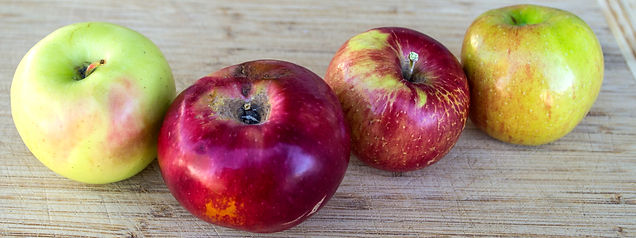We Are Seeking A Few Good Volunteers!
Volunteers for this project participate between 6 and 8 hours each month between mid January and late October. This commitment may vary with seasons and weather though we are continually attempting to use methods or technology that reduces the time required to complete our tasks. An important aspect of this project, is that the activities coincide with both the seasonal cycles of tree growth and fruiting, and the (repetitive) life cycles of pest and predator insects. What this means for volunteers and the project tasks, is that we must complete each task in sequence and at the correct time in order to obtain desired results. This also means that we plan classroom instruction and fall pruning during the early evening hours, and we plan spraying for pests in the early morning, when the winds are quiet. We use organically approved pesticide treatments and Integrated Pest Management (IPM) methods. We have not used chemical pesticides. Instead, we apply two different types of insecticidal bacterium (targeting caterpillar larva of the fruit pests). These products are labeled as "Acceptable for use on edible plants up to the day of harvest." A portion of the CHCM volunteer training includes the use of protective clothing, safety equipment, and the safe use of hand tools needed for the work. Anyone considering becoming a Volunteer-in-Training for this project will need to be prepared for some regular study of the materials provided, for some strenuous physical activity, and for working in a small team with other people who share these common interests.
The community Horticulture and Cider Making Project represents small scale fruit tree production.
The tree sites are not in orchards (no tractor work), but are in small groves 6 - 20 trees at a site.
At this time we have enrolled 42 heritage apple trees (75 years and older) that have acclimated
to our climate and soils since the 1850s. Because of that adaptation, the flavor of the fruit is
unique to our region. These trees continue producing fruit. Some apples are known varieties,
others we will need to identify, others are unidentified at this time. This is typical of heritage
apples since tree nurseries only carry a tiny faction of the more than 4,500 estimated varieties
of apples that have been propagated in the United States since the country was founded. Many
of the oldest trees have become unknown varieties, making them a regional treasure that are
even more important to restore. Given all of this perspective, volunteers in training for this
project will embark on a kind of journey, to restore trees and hold secrets of Nevada's founding
history, and a portion of America's culinary legacy.
As CHCM volunteers, we are responsible for pruning, spraying, and providing cultural practices at
tree sites with support and instruction of an ISA (international Society of Arboriculture) certified arborist who consults with the project. Other site tasks may include raking, mulching, and piling limbs or painting and covering tree trunks, or release Lady Bird Beetles. Project and other volunteers will engage in harvesting the fruit and learning how to make sweet apple cider and how to store whole apples. Volunteers will be responsible for getting themselves to and from sites (carpooling is encouraged). The tools will be transported by the project manager (including ladders, sprayers, pesticides, saws, etc. Volunteers are responsible for their own snacks/water, clothing (including gloves, jackets, boots), health/accident insurance, and first aid (though a First Aid kit will be available on site) There may be other incidentals that volunteers will be responsible to provide but, given it is a pilot project, we will all be learning some of the unknowns together, as we do the work.


Reasons for participating in the CHCM project
As a Volunteer-in-Training – select participates receive horticultural instruction, supervised practice at local heritage apple tree sites, and an opportunity to participate in an annual community sweet cider making activity and to become part of reclaiming a portion of Nevada's history.
As an Heritage Tree Owner-The project benefits owners of local heritage apple groves of fallow and/or derelict trees by making available an affordable expertise from trained and supervised local volunteers to restore and care for the trees and assist with harvesting and marketing the fruit.
Community Members as Apple Consumers – will rediscover this culinary treasure of our local food shed for the first time in generations, by participating in apple tasting and cider making while joining with friends and neighbors to support the apple diversity of our community and learning about this Northern Nevada specialty crop and agricultural legacy.
This project website, and all associated material, is supported in part by the Nevada State Department of Agriculture. Its contents are solely the responsibility of the authors and do not necessarily represent the official views of the Nevada State Department of Agriculture, Plant Division or the State of Nevada.
